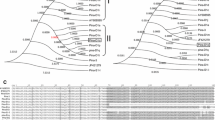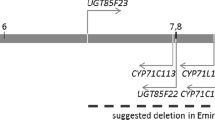Abstract
The barley hordoindoline genes (Hina and Hinb) are homologous to the wheat puroindoline genes (Pina and Pinb). These genes are involved in grain hardness, which is an important quality for barley processing. We identified novel variants of Hina and Hinb in 10 wild Hordeum species (H. bogdanii, H. brachyantherum, H. bulbosum, H. chilense, H. comosum, H. marinum, H. murinum, H. patagonicum, H. pusillum, and H. roshevitzii) covering all Hordeum genomes and preliminarily named them Hinc. These nucleotide sequences were highly similar to those of Puroindoline b-2 variant genes (Pinb-2v) and were located on chromosome 7I in H. chilense. The Hinc genes in H. bogdanii, H. bulbosum, H. patagonicum, and H. roshevitzii were pseudogenes possessing in-frame stop codons. We also found a partial Hinc sequence in H. murinum. This gene was not found in cultivated barley and H. vulgare subsp. spontaneum. The phylogenetic tree of Gsp-1, Hin, and Pin genes demonstrates that Hinc and Pinb-2v genes formed one cluster. Therefore, we considered that Hinc and Pinb-2v genes shared a common ancestral gene and were homologous to each other. We also studied the evolutional process of Gsp-1, Hin, and Pin genes. Our results suggested that Gsp-1 might be the most closely related to a putative ancestral gene on Ha locus.






Similar content being viewed by others
References
Blattner FR (2004) Phylogenetic analysis of Hordeum (Poaceae) as inferred by nuclear rDNA ITS sequences. Mol Phylogenet Evol 33:289–299
Blattner FR (2009) Progress in phylogenetic analysis and a new infrageneric classification of the barley genus Hordeum (Poaceae: Triticeae). Breed Sci 59:471–480
Blochet JE, Chevalier C, Forest E, Pebay PE, Gautier MF, Joudrier P, Pézolet M, Marion D (1993) Complete amino acid sequence of puroindoline, a new basic and cystine-rich protein with a unique tryptophan-rich domain, isolated from wheat endosperm by Triton X-114 phase partitioning. FEBS Lett 329:336–340
Caldwell KS, Langridge P, Powell W (2004) Comparative sequence analysis of the region harboring the hardness locus in barley and its colinear region in rice. Plant Physiol 136:3177–3190
Caldwell KS, Russell J, Langridge P, Powell W (2006) Extreme population-dependent linkage disequilibrium detected in an inbreeding plant species, Hordeum vulgare. Genetics 172:557–567
Chantret N, Cenci A, Sabot F, Anderson O, Dubcovsky J (2004) Sequencing of the Triticum monococcum Hardness locus reveals good microcolinearity with rice. Mol Genet Genomics 271:377–386
Chantret N, Salse J, Sabot F, Rahman S, Bellec A, Laubin B, Dubois I, Dossat C, Sourdille P, Joudrier P, Gautier MF, Cattolico L, Beckert M, Aubourg S, Weissenbach J, Caboche M, Bernard M, Leroy P, Chalhoub B (2005) Molecular basis of evolutionary events that shaped the hardness locus in diploid and polyploid wheat species (Triticum and Aegilops). Plant Cell 17:1033–1045
Charles M, Tang H, Belcram H, Paterson A, Gornicki P, Chalhoub B (2009) Sixty million years in evolution of soft grain trait in grasses: emergence of the softness locus in the common ancestor of Pooideae and Ehrhartoideae, after their divergence from Panicoideae. Mol Biol Evol 26:1651–1661
Chen F, Beecher BS, Morris CF (2010a) Physical mapping and a new variant of Puroindoline b-2 genes in wheat. Theor Appl Genet 120:745–751
Chen F, Zhang FY, Cheng XY, Morris CF, Xu HX, Dong ZD, Zhan KH, He ZH, Xia XC, Cui DQ (2010b) Association of Puroindoline b-B2 variants with grain traits, yield components and flag leaf size in bread wheat (Triticum aestivum L.) varieties of the Yellow and Huai Valleys of China. J Cereal Sci 52:247–253
Chen F, Xu HX, Zhang FY, Xia XC, He ZH, Wang DW, Dong ZD, Zhan KH, Cheng XY, Cui DQ (2011) Physical mapping of puroindoline b-2 genes and molecular characterization of a novel variant in durum wheat (Triticum turgidum L.). Mol Breed 28:153–161
Chen F, Shang X, Morris CF, Zhang FY, Dong ZD, Cui DQ (2013) Molecular characterization and diversity of puroindoline b-2 variants in cultivated and wild diploid wheat. Genet Resour Crop Evol 60:49–58
Darlington HF, Rouster J, Hoffmann L, Halford NG, Shewry PR, Simpson DJ (2001) Identification and molecular characterisation of hordoindolines from barley grain. Plant Mol Biol 47:785–794
Gautier MF, Cosson P, Guirao A, Alary R, Joudrier P (2000) Puroindoline genes are highly conserved in diploid ancestor wheats and related species but absent in tetraploid Triticum species. Plant Sci 153:81–91
Giroux MJ, Morris CF (1998) Wheat grain hardness results from highly conserved mutations in the friabilin components puroindoline a and b. Proc Natl Acad Sci USA 95:6262–6266
Krishnamurthy K, Giroux MJ (2001) Expression of wheat puroindoline genes in transgenic rice enhances grain softness. Nat Biotechnol 19:162–166
Law CN, Young CF, Brown JWS, Snape JW, Worland AJ (1978) The study of grain-protein control in wheat using whole chromosome substitution lines. In: Seed protein improvement by nuclear techniques. IAEA, Vienna, pp 483–502
Li WT, Huang X, Wang JR, Chen GY, Nevo E, Zheng YL, Wei YM (2010) Genetic analysis and ecological association of Hina genes based on single nucleotide polymorphisms (SNPs) in wild barley, Hordeum spontaneum. Heredity 147:18–26
Massa AH, Morris CF (2006) Molecular evolution of the Puroindoline-a, Puroindoline-b, and grain softness protein-1 genes in the tribe Triticeae. J Mol Evol 63:526–536
Mattern PJ, Morris R, Schmidt JW, Johnson VA (1973) Location of genes for kernel properties in wheat variety ‘Cheyenne’ using chromosome substitution lines. In: Sears ER, Sears LMS (eds) proceeding 4th international wheat genet symposium, Columbus, Missouri, pp 703–707
Miller TE, Reader SM, Chapman V (1982) The addition of Hordeum chilense chromosomes to wheat. In: Broertjes C (ed) Induced variability in plant breeding. International symposium of Eucarpia, mutation and polyploidy section, Pudoc, Wageningen, pp 79–81
Morris CF (2002) Puroindolines: the molecular genetic basis of wheat hardness. Plant Mol Biol 48:633–647
Nei M (1972) Genetic distance between populations. Am Nat 106:283–292
Phillips RL, Palombo EA, Panozzo JF, Bhave M (2011) Puroindolines, Pin alleles, hordoindolines and grain softness proteins are sources of bactericidal and fungicidal peptides. J Cereal Sci 53:112–117
Ramalingam A, Palombo EA, Bhave M (2012) The Pinb-2 genes in wheat comprise a multigene family with great sequence diversity and important variants. J Cereal Sci 56:171–180
Rouvés S, Boef C, Zwickert-Menteur S, Gautier MF, Bernard M, Joudrier P, Jestin L (1996) Locating supplementary RFLP markers on barley chromosome 7 and synteny with homeologous wheat group 5. Plant Breed 115:511–513
Saitou N, Nei M (1987) The neighbor-joining method: a new method for reconstructing phylogenetic trees. Mol Bio Evol 4:406–425
Takahashi A, Ikeda TM, Takayama T, Yanagisawa T (2010) A barley hordoindoline mutation resulted in an increase in grain hardness. Theor Appl Genet 120:519–526
Terasawa Y, Rahman SM, Takata K, Ikeda TM (2012) Distribution of Hordoindoline genes in the genus Hordeum. Theor Appl Genet 124:143–151
The International Barley Genome Sequencing Consortium (2012) A physical, genetic and functional sequence assembly of the barley genome. Nature 491:711–716
Thompson JD, Higgins DG, Gibson TJ (1994) ClustalW: improving the sensitivity of progressive multiple sequence alignment through sequence weighting, position-specific gap penalties and weight matrix choice. Nucleic Acids Res 22:4673–4680
Tranquilli G, Heaton J, Chicaiza O, Dubcovsky J (2002) Substitutions and deletions of genes related to grain hardness in wheat and their effect on grain texture. Crop Sci 42:1812–1817
Turuspekov Y, Beecher B, Darlington Y, Bowman J, Blake TK, Giroux MJ (2008) Hardness locus sequence variation and endosperm texture in spring barley. Crop Sci 48:1007–1019
Wilkinson M, Wan Y, Tosi P, Leverington M, Snape J, Mitchel RAC, Shewry PR (2008) Identification and genetic mapping of variant forms of puroindoline b expressed in developing wheat grain. J Cereal Sci 48:722–728
Acknowledgments
This work was supported by the Bio-oriented Technology Research Advancement Institution. We express our sincere gratitude to Dr. Shin Taketa for providing material support. We also grateful to Dr. Yoichi Hayakawa and Ms. Kimiko Suginohara for their helpful technical assistance.
Author information
Authors and Affiliations
Corresponding author
Rights and permissions
About this article
Cite this article
Terasawa, Y., Takata, K., Anai, T. et al. Identification and distribution of Puroindoline b-2 variant gene homologs in Hordeum . Genetica 141, 359–368 (2013). https://doi.org/10.1007/s10709-013-9735-4
Received:
Accepted:
Published:
Issue Date:
DOI: https://doi.org/10.1007/s10709-013-9735-4




